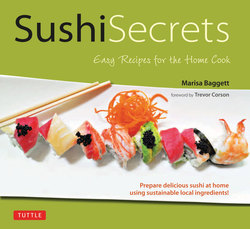Читать книгу Sushi Secrets - Marisa Baggett - Страница 8
На сайте Литреса книга снята с продажи.
ОглавлениеGetting Started–The Eight Basic Kinds of Sushi
Chances are, you’re eager to get rolling, but first things first. Becoming familiar with the various forms of sushi, proper pantry staples, equipment, and seafood for sushi should be at the top of all aspiring home sushi chef ’s list. Having knowledge of the basic kinds of sushi can expand palates and even flexibility in the event that things don’t go as planned. Knowing how to purchase and store the essentials can save money. Having the necessary tools makes sushi preparation easy. And the benefits of selecting great seafood products easily extend beyond the realm of sushi.
When planning to prepare sushi keep in mind all of the various forms. Most likely, the different types of sushi rolls, or maki, instantly come to mind. Consider exploring other forms of sushi. Each has its own set of preparation techniques and advantages for maximizing the selected fillings and toppings. The methods of enjoying each type of sushi vary, too. Chop-sticks are certainly a favorite method for those that are dextrous, but many forms of sushi are acceptable finger foods.
Nigiri Sushi
Nigiri or hand formed sushi fingers, is the crown jewel of sushi. Prime, colorful cuts of the freshest seafood are draped gracefully over thoughtfully formed beds of hand squeezed rice. Toppings such as raw seafood lay in place, but cooked seafood and many vegetables require the help of a nori “seatbelt” to hold them securely in place during the movement from dish to mouth.
Pressed Sushi (Oshi Sushi)
If sushi had a sandwich, this would be it. Pressed sushi is layers of Sushi Rice and various fillings. Special presses can be used to literally press the finished product through to a cutting board where it is sliced into manageable pieces. When special sushi presses are unavailable, Sushi Rice can be layered with fillings, molded in a bowl or dish, unmolded, and cut much in the same fashion.
Battleship Sushi (Gunkan Maki)
Battleship sushi is the translated name given to these little bites. Gunkan maki are much like nigiri in that they begin as a similar hand squeezed bed of rice. Then, a wide strip of nori is wrapped around the bed of rice to form an elongated “battleship” that is ideal for filling. Such fillings include various fish roes, chopped, or sliced seafood and other toppings that are a bit too moist or loose for inclusion inside completely enclosed sushi rolls.
Thin Rolls (Hoso Maki)
Thin sushi rolls are sushi simplicity. One or two fillings are rolled into small bite sized pieces. These are best for showcasing one or two flavors, like pristine cuts of seafood, grilled meat, or deliciously seasoned vegetables.
Thick Rolls (Futo Maki)
Thick sushi rolls present a big bite. Try these out first if you have a tendency for going overboard. Futo maki can accommodate an abundance of ingredients. Just keep in mind that thick rolls still fall under the one-bite category. No matter how thick the rolls, they should still be eaten in one bite.
Inside-out Rolls (Ura Maki)
Ura maki are probably the most recognizable sushi rolls. They are referred to as inside out rolls because the rice rather than the nori is on the outside. While some may think of this as a way to mask the flavor of the seaweed, I prefer to think of it as a way to showcase sushi’s vital and most essential ingredient—the Sushi Rice.
Hand Rolls (Te Maki)
Call it a sushi burrito or call it a sushi cone. Regardless, the method for consumption is the same. Nori is filled with Sushi Rice and desired fillings then wrapped into a personal cone. These are not meant to be cut before serving. Simply take bites from the cone and enjoy.
Bowl Sushi (Chirashi)
It is quite easy to understand why this is commonly considered a “sushi salad.” chirashi sushi starts off with a base of Sushi Rice in a bowl topped with carefully placed or scattered toppings. Toppings can include fresh or pickled vegetables, seafood, fruit, or even smoked meats. While easy to make, eating may require a steady hand. The mastery of chopstick use is essential as chirashi is essentially a bowl of rice and toppings. It is perfectly acceptable to use a fork if your chopstick skills are not quite there yet.
